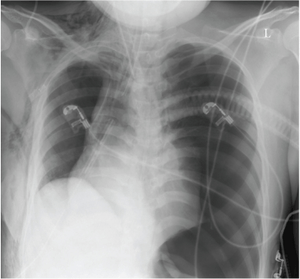Tension pneumothorax
Background
- Death occurs from hypoxic respiratory arrest (V-Q mismatch), not circulatory arrest
Clinical Features
- Unilateral diminished or absent breath sounds
- Hypotension or evidence of hypoperfusion
- Distended neck veins
- May not occur if patient is hypovolemic
- Contralateral Tracheal deviation (late sign)
- Type of obstructive shock since prevents venous return to the right side of the heart
Differential Diagnosis
Pneumothorax Types
Thoracic Trauma
- Airway/Pulmonary
- Cardiac/Vascular
- Cardiac injury
- Blunt cardiac injury
- Penetrating cardiac injury
- Cardiac tamponade
- Traumatic aortic transection
- Cardiac injury
- Musculoskeletal
- Other
Emergent
- Pulmonary
- Airway obstruction
- Anaphylaxis
- Angioedema
- Aspiration
- Asthma
- Cor pulmonale
- Inhalation exposure
- Noncardiogenic pulmonary edema
- Pneumonia
- Pneumocystis Pneumonia (PCP)
- Pulmonary embolism
- Pulmonary hypertension
- Tension pneumothorax
- Idiopathic pulmonary fibrosis acute exacerbation
- Cystic fibrosis exacerbation
- Cardiac
- Other Associated with Normal/↑ Respiratory Effort
- Abdominal distension
- Anemia
- CO Poisoning
- Salicylate toxicity
- Diabetic ketoacidosis (DKA)
- Diaphragm injury
- Electrolyte abnormalities
- Epiglottitis
- Flail chest
- Hypotension
- Metabolic acidosis
- Pneumonia
- Pneumothorax/hemothorax
- Renal Failure
- Sepsis
- Toxic ingestion
- Other Associated with ↓ Respiratory Effort
Pediatric-specific
- Aspirated foreign body
- Respiratory distress syndrome
- Meconium aspiration syndrome
- Bronchiolitis (peds)
- Pertussis
- Bronchopulmonary dysplasia
- Croup
- Bacterial tracheitis
- Tracheomalacia
- Congenital heart disease
- Vascular ring
- Neonatal abstinence syndrome
- Inborn errors of metabolism
- Brief resolved unexplained event
- Normal neonatal periodic breathing (misinterpreted by caregivers as abnormal)
Non-Emergent
- ALS
- Ascites
- Uncorrected ASD
- Congenital heart disease
- COPD exacerbation
- Fever
- Hyperventilation
- Interstitial lung disease
- Neoplasm
- Obesity
- Panic attack
- Pleural effusion
- Polymyositis
- Porphyria
- Pregnancy
- Rib fracture
- Spontaneous pneumothorax
- Thyroid Disease
- URI
Evaluation

Left sided tension pneumothorax with mediastinal shift
Ideally a clinical diagnosis treated emergently (without delay for studies)
Lung ultrasound of pneumothorax
- No lung sliding seen (not specific for pneumothorax)
- May also identify "lung point": distinct point where you no longer see lung sliding (pathognomonic)
- Evaluate other intercostal spaces because pneumothorax may only be seen in least dependent area of thorax
- NO comet tail artifact
- Bar Code appearance/"Stratosphere" sign on M-mode (absence of "seashore" waves)
Management
- Immediate needle thoracostomy
- 14ga IV in midclavicular line just above the rib at the second intercostal space
- Always followed by Chest Tube placement
Pediatric Chest Tube
- Estimated as 4*ETT
- ETT=(4+age/4)
Adult Chest Tube Sizes
| Chest Tube Size | Type of Patient | Underlying Causes |
| Small (8-14 Fr) |
|
|
| Medium (20-28 Fr) |
|
|
| Large (36-40 Fr) |
|
Disposition
- Admit
Special Instructions
Flying
- Can consider flying 2 weeks after full resolution of traumatic pneumothroax[3]
Complications
References
- Inaba Et. al J Trauma Acute Care Surg. 2012 Feb;72(2):422-7.
- Advanced Trauma Life Support® Update 2019: Management and Applications for Adults and Special Populations.
- "Management of spontaneous pneumothorax: British Thoracic Society pleural disease guideline 2010" British Thoracic Society Guidelines. Thorax 2010;65:ii18-ii31 doi:10.1136/thx.2010.136986 PDF
This article is issued from
Wikem.
The text is licensed under Creative
Commons - Attribution - Sharealike.
Additional terms may apply for the media files.


